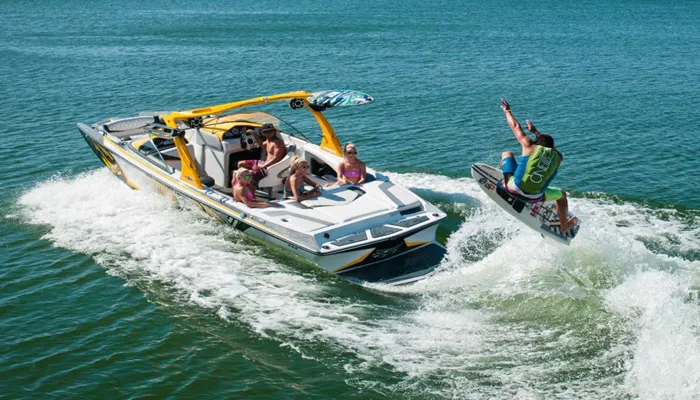Wakeboarding is an exhilarating water sport that combines the thrill of surfing, snowboarding, and water skiing. One of the most critical elements to a successful wakeboarding session is how the boat is driven. The boat’s speed, wake size, and smoothness of the ride directly affect the wakeboarder’s performance and safety. Whether you are a boat owner, a driver, or a wakeboarding enthusiast eager to learn, understanding how to drive a boat specifically for wakeboarding is essential.
In this comprehensive guide, we will walk you through everything you need to know about driving a boat for wakeboarding—from preparation and safety checks to mastering speed control and wake shaping. By the end, you’ll be equipped with expert knowledge to provide the best possible wakeboarding experience.
Introduction to Wakeboarding and Boat Driving
Wakeboarding involves riding a wakeboard over the surface of a body of water, usually behind a motorboat. The boat creates a wake—a wave pattern—that the rider uses to perform tricks and jumps. Unlike regular boating, driving a boat for wakeboarding requires precise control over speed, wake size, and smoothness. The driver must maintain consistent speed, anticipate the rider’s moves, and ensure safety for everyone involved.
The boat used for wakeboarding typically has a powerful engine and specialized features such as ballast tanks or wake-shaping devices to create larger wakes. However, the driver’s skill in managing these features and the boat’s speed is what truly makes the difference.
Step 1: Preparing Your Boat for Wakeboarding
Check and Adjust Ballast Systems
Most modern wakeboarding boats come equipped with ballast tanks or bags that can be filled with water to increase the boat’s weight. This added weight helps create larger, more defined wakes. Before heading out:
Ensure ballast tanks are functioning properly.
Fill the tanks according to the number of riders and desired wake size.
Distribute weight evenly to avoid uneven wakes or unsafe handling.
Inspect Safety Equipment
Safety is paramount. Before starting, verify that:
Life jackets are available and worn by all riders.
The boat’s kill switch lanyard is attached to the driver.
The fire extinguisher, first aid kit, and communication devices are onboard and accessible.
The boat’s engine, steering, and throttle controls are working smoothly.
Plan Your Route and Wakeboarding Area
Choose a location with calm water, minimal boat traffic, and enough open space. Avoid shallow areas, obstacles, and no-wake zones. Inform all participants about the planned route and signals to communicate.
Step 2: Understanding the Ideal Wakeboarding Speed
Typical Wakeboarding Speeds
Wakeboarders generally prefer speeds between 18 to 24 miles per hour (29 to 39 km/h). The exact speed depends on:
Rider’s skill level: Beginners need slower speeds (~18 mph), while advanced riders may prefer faster speeds (~22-24 mph).
Rider’s weight: Heavier riders may require slightly higher speeds.
Wake size and shape preferences.
Maintaining a Consistent Speed
Consistency is crucial. Sudden acceleration or deceleration can unbalance the rider and increase the risk of falls or injuries.
Use cruise control if your boat has it, or practice smooth throttle control to maintain steady speed.
Step 3: Starting the Wakeboarding Session
Positioning the Rider and Boat
Have the rider sit on the swim platform or a secure spot near the rear.
Attach the tow rope to the boat’s designated towing point, usually a tower or pylon.
Ensure the rope is untangled and the rider has a firm grip.
Communicating with the Rider
Establish hand signals or use a waterproof communication system to coordinate starts, stops, speed changes, and emergencies.
Smooth Takeoff
Start the boat slowly to avoid jerking the rider.
Gradually increase speed until the rider is planing on the water.
Once the rider is stable, adjust speed to the agreed level.
Step 4: Driving Techniques to Optimize the Wake
Creating the Perfect Wake
The wakeboarder relies on the wake’s shape and size for jumps and tricks. To optimize the wake:
Use ballast tanks to increase the boat’s weight.
Adjust the boat’s trim tabs or wake-shaping devices to fine-tune the wake’s shape.
Drive in a straight line at a consistent speed to produce clean wakes.
Making Smooth Turns
Avoid sharp or sudden turns; these can destabilize the rider.
When turning, gradually increase the radius to maintain wake quality.
Communicate with the rider before changing direction or speed.
Handling Multiple Riders
If towing more than one rider, adjust ballast and speed accordingly. Be aware that wakes will differ, and prioritize safety by maintaining clear communication and slower speeds.
Step 5: Safety Considerations While Driving
Always Keep an Eye on the Rider
The driver should have a spotter or use mirrors to monitor the rider at all times. This helps detect falls or distress quickly.
Avoid Crowded or Restricted Areas
Respect local boating laws, no-wake zones, and avoid congested waterways to minimize accidents.
Emergency Procedures
Be prepared to stop the boat immediately if the rider falls or signals distress. Practice quick response drills with your crew.
Step 6: Post-Session Boat Care and Rider Feedback
Cooling Down the Engine
After the session, idle the boat for a few minutes to cool the engine and prevent overheating.
Draining Ballast Tanks
Empty ballast tanks to reduce weight and improve fuel efficiency for regular boating.
Gathering Rider Feedback
Ask the rider about wake quality, speed comfort, and any issues encountered. Use this feedback to adjust your driving for future sessions.
Conclusion
Driving a boat for wakeboarding is both an art and a science. It requires understanding the mechanics of wake creation, mastering speed control, and prioritizing safety. By preparing your boat properly, maintaining consistent speeds, communicating effectively with the rider, and practicing smooth driving techniques, you can significantly enhance the wakeboarding experience.
Whether you’re a boat owner looking to support your wakeboarding friends or a driver aiming to improve your skills, following this step-by-step guide will help you become a confident and skilled wakeboarding boat driver. Remember, the ultimate goal is to provide a thrilling yet safe environment where riders can push their limits and enjoy the sport to the fullest.

